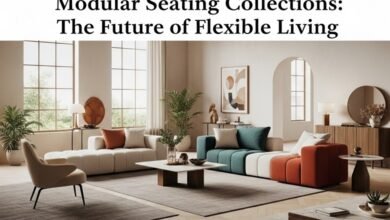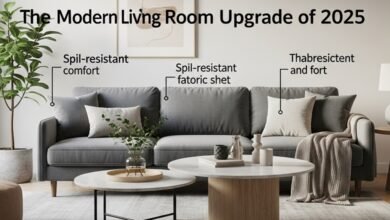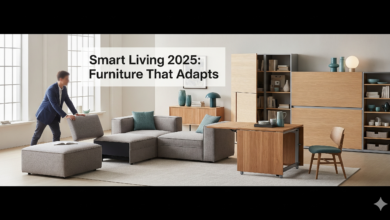Sustainable & Multifunctional Furniture – The Future of Modern Living
In a world where eco-conscious living and space efficiency are at the forefront of design trends, sustainable & multifunctional furniture has become the new standard for modern homes. From fold-out desks made with recycled wood to sofas that double as storage units, these pieces reflect both responsible consumer choices and practical lifestyle solutions.
Let’s dive into why these designs are trending in 2025, how they compare to traditional furniture, and what makes them worth investing in.
🌍 The Rise of Sustainability in Furniture
Sustainability in furniture isn’t just about using “green materials.” It’s a holistic approach that considers:
- 🌱 Eco-Friendly Materials – Bamboo, reclaimed wood, cork, recycled metal, and biodegradable fabrics.
- 🔄 Circular Design – Products built to last, repairable, and recyclable at the end of their lifecycle.
- 💨 Low-Impact Manufacturing – Reducing carbon emissions and waste during production.
Compared to conventional furniture made from plastic laminates and chemically treated woods, sustainable furniture offers healthier indoor environments and a lighter footprint on the planet.
🪑 Multifunctionality – More Than Just Furniture
Urban living often comes with limited space, making multifunctional designs a necessity. Today’s furniture is no longer static—it adapts, transforms, and doubles up to serve multiple needs.
Some popular examples include:
- 🛏️ Sofa Beds – Comfortable seating by day, full beds by night.
- 📦 Storage Ottomans – Stylish decor pieces that hide clutter.
- 🖥️ Convertible Desks – Foldable or wall-mounted workspaces for remote workers.
- 🍽️ Extendable Dining Tables – Compact for daily use, expandable for guests.
Compared to traditional bulky pieces, multifunctional designs save space, money, and energy—all while making homes more dynamic.
🔑 Why It’s Trending in 2025
Several lifestyle shifts have fueled the popularity of sustainable multifunctional furniture:
- 🏙️ Urbanization & Smaller Homes – Apartments demand compact yet versatile solutions.
- 💻 Hybrid Work Culture – Home offices need furniture that adapts to changing routines.
- 🌱 Eco-Conscious Mindset – Younger generations prioritize sustainable, ethical purchases.
- 🎯 Minimalist & Flexible Living – People want less clutter, more purpose in their spaces.
In short, multifunctional and eco-friendly designs are not just stylish—they’re essential to modern living.
👍 Benefits of Sustainable Multifunctional Furniture
- ✅ Eco-Friendly – Built from renewable or recycled materials.
- ✅ Space-Saving – Perfect for small apartments or shared living.
- ✅ Cost-Effective – One piece serves multiple purposes.
- ✅ Durable & Long-Lasting – High-quality craftsmanship ensures longevity.
- ✅ Trendy Yet Timeless – Matches minimal, Scandinavian, or modern aesthetics.
⚠️ Challenges & Considerations
Of course, no trend is without drawbacks. Some limitations to consider include:
- ❌ Higher Initial Cost – Sustainable materials and multifunctional designs often cost more upfront.
- ❌ Maintenance Needs – Natural materials like wood or bamboo require extra care.
- ❌ Limited Options – While growing, the range is still narrower compared to conventional furniture.
Still, when weighed against long-term benefits, many consumers view these as worthwhile investments.
🛋️ Comparison – Traditional vs. Sustainable Multifunctional Furniture
- Traditional Furniture: Focuses on single-purpose design, often cheaper but made from synthetic or less durable materials.
- Sustainable Multifunctional Furniture: Prioritizes eco-conscious production and space efficiency, slightly pricier but offers versatility and longer lifespan.
For example, a traditional coffee table is just that—a coffee table. In contrast, a sustainable multifunctional version might include built-in storage, modular add-ons, and be crafted from reclaimed wood.
📈 Consumer Trends & Market Growth
Reports show that eco-friendly furniture demand is projected to grow steadily in the next decade. Social media platforms like TikTok and Instagram are flooded with “tiny home hacks” and “modular living solutions”, making multifunctional pieces aspirational for younger buyers.
Brands are also experimenting with rental and resale programs, ensuring furniture has a second life and stays out of landfills.
🥇 Final Verdict – A Smart Investment for Modern Homes
Sustainable & multifunctional furniture isn’t just a passing trend—it’s the future of interior design. It caters to eco-conscious consumers, meets the demands of compact urban living, and aligns with the shift toward minimalism and long-term value.
- 🌱 Choose it if you value sustainability, versatility, and timeless design.
- 🛑 Skip it only if budget is a big constraint or you prefer single-purpose statement furniture.
👉 In 2025, investing in sustainable multifunctional furniture is more than just a style choice—it’s a lifestyle commitment to smarter, greener, and more adaptable living.



